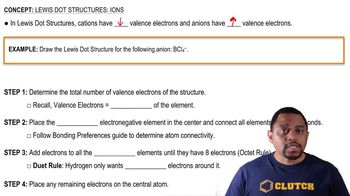Here are the essential concepts you must grasp in order to answer the question correctly.
Lewis Structure
A Lewis structure is a diagram that represents the bonding between atoms in a molecule and the lone pairs of electrons that may exist. It uses dots to depict valence electrons and lines to indicate covalent bonds between atoms. This structure provides a clear visual representation of how atoms are connected and the arrangement of electrons, which is crucial for understanding molecular geometry and reactivity.
Recommended video:
Lewis Dot Structures: Ions (Simplified) Concept 1
Condensed Structure
A condensed structure is a simplified representation of a molecule that shows the connectivity of atoms without depicting all the individual bonds and lone pairs. In this format, atoms are written in sequence, often with subscripts to indicate the number of atoms of each type, making it easier to read and write complex molecules. This structure emphasizes the overall composition and connectivity rather than the detailed electron arrangement.
Recommended video:
Condensed Formula Concept 1
Bonds and Atoms Representation
The representation of bonds and atoms in chemical structures is fundamental to understanding molecular interactions. In Lewis structures, bonds are explicitly shown as lines, while in condensed structures, they are implied through the arrangement of atoms. Recognizing how these representations differ helps in visualizing molecular shapes, predicting reactivity, and understanding the physical and chemical properties of substances.
Recommended video:
 Verified step by step guidance
Verified step by step guidance


